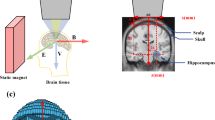Abstract
This paper develops a model of 2-dimensional anisotropic cardiac tissue which permits the examination of the electrical sources arising from excitation at a point. The specific results depend on the anisotropy parameters and two cases are considered in detail. For assumed equal anisotropicity ratios in the interstitial and intracellular space the isochrones are (asymptotically) confocal ellipses and the total double layer source is (asymptotically) uniform. Surface fields are calculated and plotted for this condition. (For nonequal anisotropy ratios the total double layer source is necessarily nonuniform). When the preparation is very thin so that all fibres are essentially in contact with the extracellular medium the isochrones are (asymptotically) confocal ellipses but the total double-layer sources are now nonuniform. The sources for this case are determined and the fields at the surface of the cardiac tissue evaluated and plotted. The aforementioned ‘thin’ and ‘thick’ tissue preparations are contrasted with each other and the effects of anisotropicity in cardiac tissue discussed.
Similar content being viewed by others
References
Barr, R. C. andSpach, M. S. (1978) Inverse calculation of QRS-T epicardial potentials from body surface potential distributions for normal and ectopic beats in the intact dog.Circ. Res.,42, 661.
Baruffi, S. et al. (1978) The importance of fiber orientation in determining the features of the cardiac electric fieldin Antaloczy, Z. (Ed.) Modern Electrocardiology. Exerpta Medica, Oxford.
Clerc, L. (1976) Directional differences of impulse spread in trabecular muscle from mammalian heart.J. Physiol.,255, 355.
Corbin, L. V. II andScher, A. M. (1977) The canine heart as an electrocardiographic generator.Circ. Res.,41, 58.
Draper, M. H. andMya-Tu, M. (1959) A comparison of the conduction velocity in cardiac tissues of various mammals.Q.J. Exp. Physiol.,41, 91.
Eifler, W. andPlonsey, R. (1975) A cellular model for the simulation of activation in the ventricular myocardium.J. Electrocard.,8, 117.
Hodgkin, A. L. (1954) A note on conduction velocity.J. Physiol.,125, 221.
Joyner, R. W., Ramon, F. andMoore, J. W. (1975) Simulation of action potential propagation in an inhomogeneous sheet of coupled excitable cells.Circ. Res.,36, 654.
McFee, R. andRush, S. (1968) Qualitative effects of thoracic resistivity variations on the interpretation of electrocardiograms: the low-resistance surface layer.Am. Heart J.,76, 48.
Muler, A. L. andMarkin, V. S. (1977a) Electrical properties of anisotropic nerve-muscle syncytia II. Spread of flat front of excitation,Biofizika,22, 518.
Muler, A. L. andMarkin, V. S. (1977b) Electrical properties of anisotropic nerve-muscle syncytia—III. Steady form of the excitation front.Biofizika,22, 671.
Plonsey, R. (1974a) The active fiber in a volume conductor.IEEE Trans.,BME-21, 371.
Plonsey, R. (1974b) An evaluation of several cardiac activation models.J. Electrocard.,7, 237.
Plonsey, R. andCollin, R. (1961)Principles and applications of electromagnetic fields, McGraw-Hill Book Co., NY.
Sano, T., Takayama, N. andShimamoto, T. (1959) Directional difference of conduction velocity in the cardiac ventricular syncytium studied by micro-electrodes.Circ. Res.,7, 262.
Spach, M. S. et al. (1971) Collision of excitation waves in the dog Purkinje system.Circ. Res.,29, 499.
Spach, M. S. et al. (1972) Spread of excitation from the atrium into thoracic veins in human beings and dogs.Am. J. Cardiol.,30, 844.
Spach, M. S., Miller, W. T. III, Miller-Jones, E., Warren, R. B. andBarr, R. C. (1979) Extracellular potentials related to intracellular action potentials during impulse conduction in anisotropic canine cardiac muscle.Circ. Res. 45, 188.
Streetor, D. D. et al. (1969) Fiber orientation in the canine left ventricle during diastole and systole.Circ. Res.,24, 339.
Ushiyama, J. (1971) Cardiac action potentials recorded from the site at which two impulses of excitation have collided.In Kao, F. F. (Ed.)Research in physiology (A liber memorialis in honor of Prof. Chandler, McCuskey Brooks), Bologna, Italy.
Vick, R. L. et al. (1970) Distribution of potassium, sodium and chloride in canine Purkinje and ventricular tissues.Circ. Res.,27, 159.
Author information
Authors and Affiliations
Rights and permissions
About this article
Cite this article
Plonsey, R., Rudy, Y. Electrocardiogram sources in a 2-dimensional anisotropic activation model. Med. Biol. Eng. Comput. 18, 87–94 (1980). https://doi.org/10.1007/BF02442485
Received:
Accepted:
Issue Date:
DOI: https://doi.org/10.1007/BF02442485




